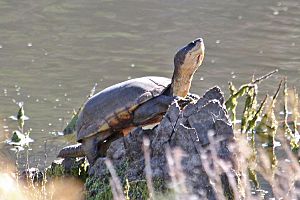Arizona mud turtle facts for kids
Quick facts for kids Arizona mud turtle |
|
|---|---|
 |
|
| Conservation status | |
| Scientific classification | |
| Genus: |
Kinosternon
|
| Species: |
stejnegeri
|
| Synonyms | |
|
|
The Arizona mud turtle (Kinosternon stejnegeri) is a small turtle. It belongs to the mud turtle family, called Kinosternidae. You can find these turtles in the deserts of Arizona in the United States. They also live in Sonora, Mexico.
These turtles are known as semi-aquatic. This means they spend time both in water and on land. They prefer temporary puddles and ponds. They usually stay away from big, permanent rivers and lakes.
Contents
Meet the Arizona Mud Turtle
The Arizona mud turtle has a unique look. Its top shell is often brown or olive-brown. It has a smooth, dome-like shape. The skin on its head is dark gray on top. The bottom and sides of its head are a light yellow or cream color. These turtles do not have special patterns or stripes on their legs or feet.
How Big Do They Get?
Male Arizona mud turtles are usually larger than females. A grown male can be about 10 to 18 centimeters (4 to 7.5 inches) long. Females are a bit smaller, growing to about 9.5 to 16.7 centimeters (3.5 to 6.5 inches) long.
What Do They Eat?
Arizona mud turtles are not picky eaters! Their diet includes many things. They eat frogs, tadpoles, and different kinds of invertebrates. They also eat small fish and even carrion (dead animals).
Where Do They Live and What Do They Do?
Arizona mud turtles live in lowland areas. You can find them at elevations between 200 and 800 meters (about 650 to 2,600 feet). They are often found in desert scrub and grassland areas. These turtles love temporary ponds and puddles. These spots give them a good supply of food.
Daily Life and Sleep Habits
These turtles are mostly active during the day. They often hang out near temporary ponds. This helps them soak up heat and save energy from the sun. During the summer, especially in July and August, they might be active at night. This is because it's warmer then, and they spend more time in the water.
When winter comes, Arizona mud turtles go into hibernation. They dig a burrow and sleep underground. If there's a drought and water is scarce, they can stay dormant underground for up to two years!
Life Cycle of the Arizona Mud Turtle
Female Arizona mud turtles lay eggs in July and early August. They usually lay between three and seven eggs. They don't have special nesting spots. They often bury their eggs close to places where they can find food. Baby turtles, called hatchlings, are small. They are about 2.5 to 2.8 centimeters (1 inch) long when they hatch. These turtles can live for 6 to 10 years.
Challenges for Arizona Mud Turtles
The Arizona mud turtle faces some dangers. Their population can decrease due to human activities. These include farming, ranching, and building things to control floods. When people build in wetlands, it can damage the turtles' homes. Getting hit by cars on roads is also a risk for these turtles.
However, there's good news too! Arizona mud turtles are good at adapting. They can even benefit when humans rebuild ponds. This helps them find new places to live and find food.


